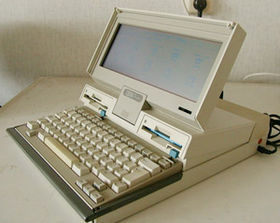- IBM PC Convertible
-
IBM PC Convertible 
IBM PC ConvertibleRelease date April 3, 1986 Introductory price US$2,000. Operating system IBM PC-DOS with custom icon-oriented shell interface CPU Intel 80c88 CPU @ 4.77 MHz Storage capacity Dual 720 kB 3.5" floppy drives Memory 256 kB of RAM (expandable to 640 kB) Display Monochrome CGA-compatible LCD screen. Graphics 80x25 (text), 640x200, and 320x200 Weight 13 pounds (5.8 kg) Successor IBM PS/2 L40 SX
IBM PS/55 noteThe IBM PC Convertible, released April 3, 1986, was IBM's first laptop computer and was also the first IBM computer to utilize the 3.5" floppy disk which went on to become the standard. Like modern laptops, it featured power management and the ability to run from batteries. It was the follow-up to the IBM Portable and was model number 5140. The concept and the design of the body was made by the German industrial designer Richard Sapper.
It utilized an Intel 80c88 CPU (a CMOS version of the Intel 8088) running at 4.77 MHz, 256 kB of RAM (expandable to 640 kB), dual 720 kB 3.5" floppy drives, and a monochrome CGA-compatible LCD screen at a price of $2,000. It weighed 13 pounds (5.8 kg) and featured a built-in carrying handle.
The PC Convertible had expansion capabilities through a proprietary ISA bus-based port on the rear of the machine. Extension modules, including a small printer and a video output module, could be snapped into place. The machine could also take an internal modem, but there was no room for an internal hard disk.
Pressing the power button on the computer did not turn it off, but put the machine into a "suspend" mode. This avoided the long process of booting up. The CMOS 80c88 CPU has a static core, which means that it can be stopped simply by stopping the system clock oscillator that is driving it, and it will hold its state indefinitely and resume processing at the point it was stopped when the clock signal is restarted, as long as it is kept powered. CMOS circuits use extremely little power when they are not changing state, so an 80c88 that is on but not being clocked uses very little power.
The screen was not very tall, so text characters and graphics were compressed vertically, appearing about half their normal height. The display was capable of resolutions of 80x25 (text), 640x200, and 320x200. Pressing a lever between the two floppy drives just below the display detached the entire screen from the unit. This feature allowed the convenient use of a full-size desktop monitor while at one's desk, an early forerunner of the "docking station" concept.
The machine sold very poorly for a number of reasons. The Convertible was heavy, not much faster than the Portable it replaced (despite the newer CMOS processor and use of static RAM), didn't come with traditional PC expansion ports (such as serial ports and a parallel port) without an add-on, and had a hard-to-read, oddly-shaped LCD screen (the first screens lacked a backlight). It also competed against faster portables based on the Intel 80286 that offered optional hard drives, from companies such as Compaq, and laptops from companies such as Toshiba and Zenith that were lighter and offered similar specifications, sometimes at half the price. With the screen, the keyboard was also widely criticized.
It was replaced in 1991 by the IBM PS/2 L40 SX, and in Japan by the IBM Personal System/55note, which was the predecessor to the ThinkPad.
See also
- IBM Portable Personal Computer
- IBM PS/2 L40 SX
- IBM PS/55 note
- History of laptops
External links
- "IBM PC Convertible". IBM Archives. IBM. http://www-03.ibm.com/ibm/history/exhibits/attic/attic_013.html. Retrieved September 11, 2006.
- "IBM Convertible 5140". Oh no, not another computer museum!. November 26, 2003. http://www.xs4all.nl/~fjkraan/comp/ibm5140/. Retrieved September 11, 2006.
- IBM-5140 Convertible and collection of old digital and analog computers at oldcomputermuseum.com
Preceded by
IBM Portable Personal ComputerIBM Personal Computers Succeeded by
IBM PS/2 L40 SXCategories:- Portable computers
- IBM laptops
Wikimedia Foundation. 2010.
